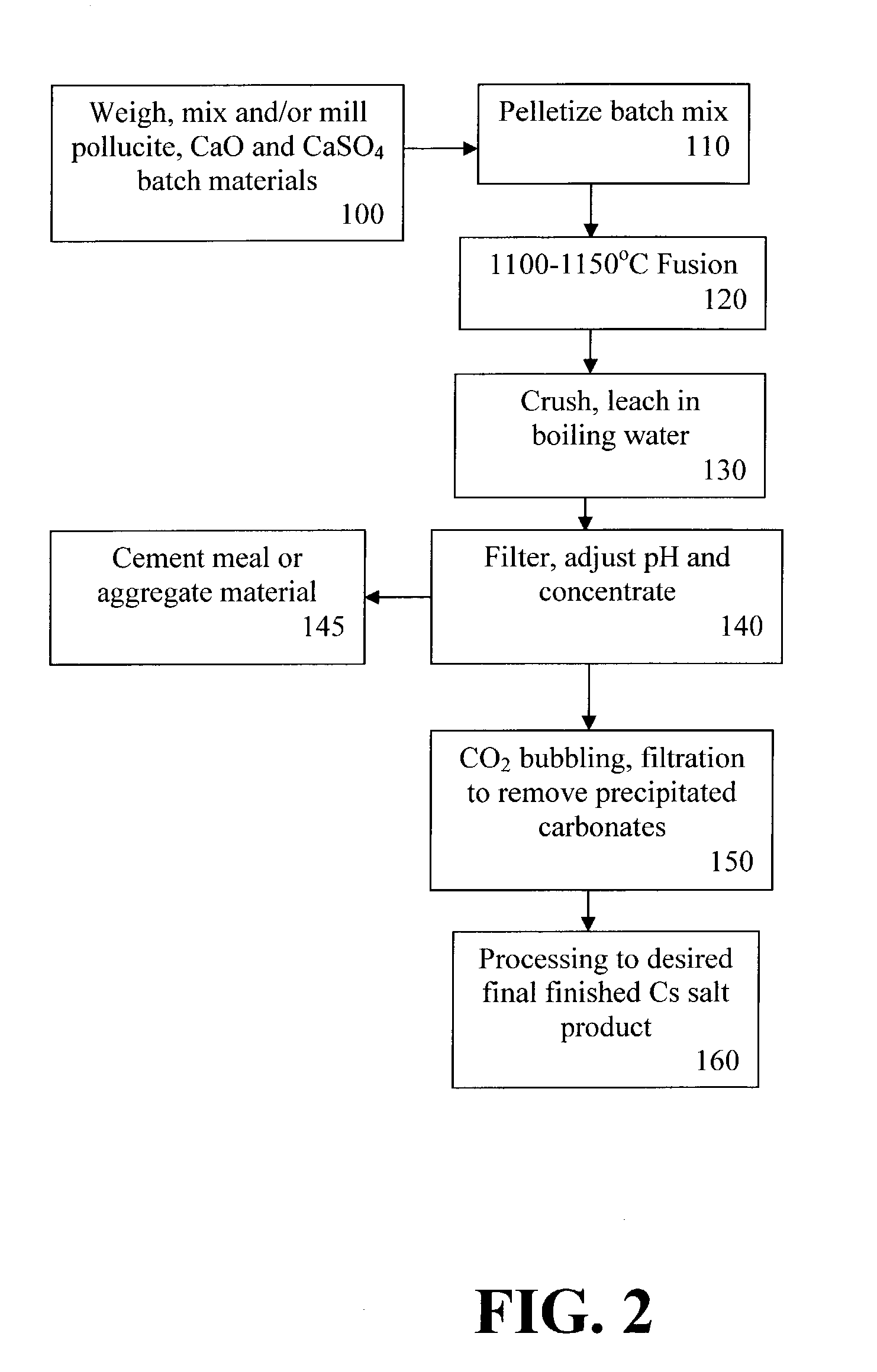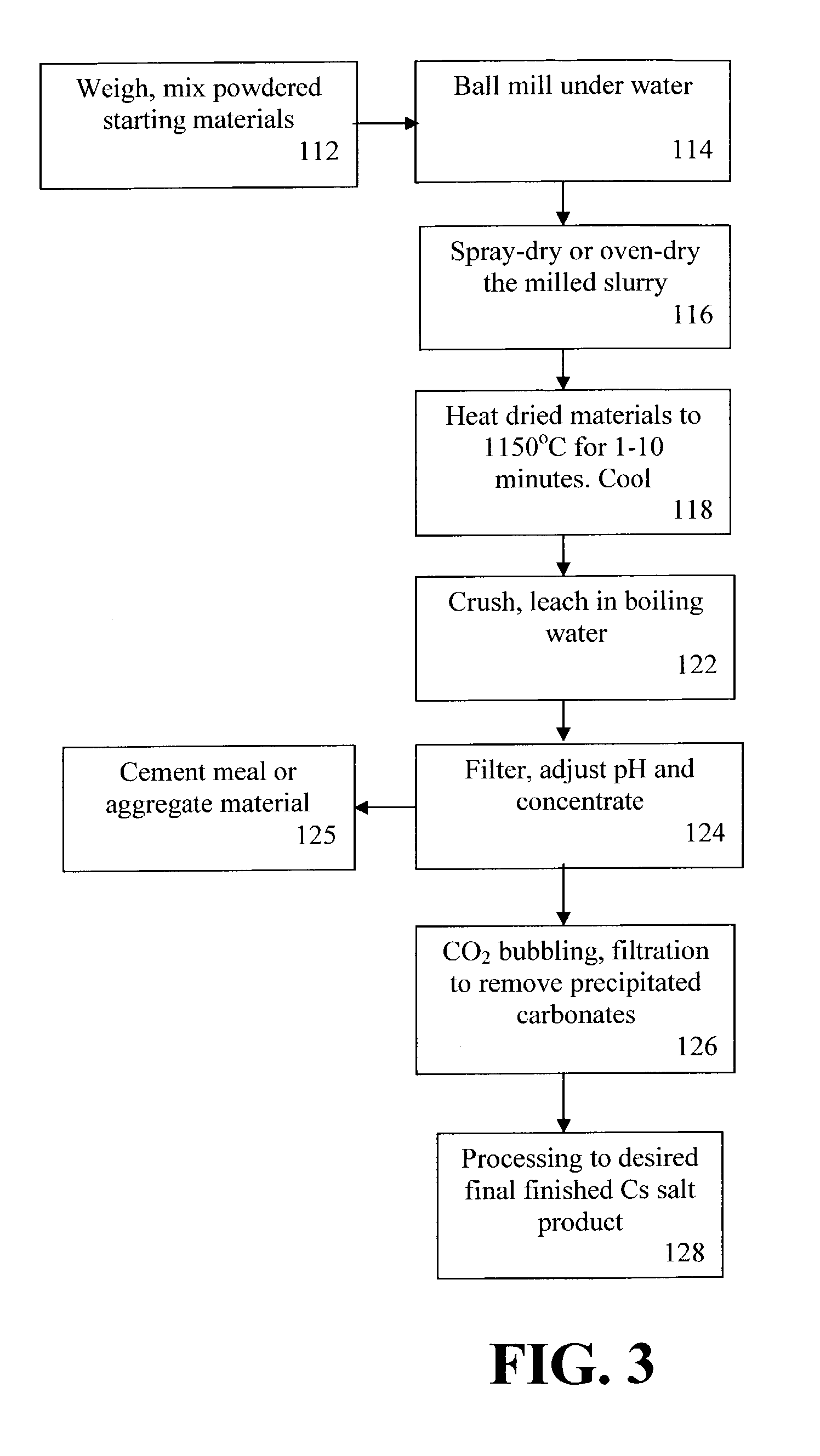Methods for recovering at least one metallic element from ore
a technology of metallic elements and ore, which is applied in the field of methods for recovering at least one metallic element from ore, can solve the problems of difficult process, high cost, and inability to achieve near 100% extraction yield of low-assay ore, and achieve the effect of reducing the need for acid treatmen
- Summary
- Abstract
- Description
- Claims
- Application Information
AI Technical Summary
Benefits of technology
Problems solved by technology
Method used
Image
Examples
example 1
[0064]Laboratory fusion trials were performed using varying pollucite / lithium sulfate ratios and fusion temperatures of either 1100° C. (giving a clinker product) or 1300° C. (giving an immiscible two-phase melt). In each trial, the test sample was held at the peak temperature for 30 minutes before being removed from the hot furnace, and then cooled and crushed to a fine powder. The crushed fusion products were used for leach tests in water, and chemical analyses were made of the resulting solutions and filter residues.
The analysis results were used to determine:
[0065](i) % Cs recovery from the pollucite ore; and[0066](ii) the compositions of the filter residues (i.e., Li-rich aluminosilicate byproduct).
[0067]Mass balance calculations, whereby the compositions of the leach solutions and filter residues are compared to the starting material compositions, were used to verify the accuracy of the chemical analyses. The results are summarized in FIGS. 4 and 5. In general, the % Cs recove...
example 2
[0069]Laboratory trials have been performed using fusion temperatures of from about 1000° C. to about 1500° C., and using the following composition ranges (weight %): pollucite, 30-80%; CaSO4, 15-70%; and CaO, 0-40%. In the trials, the starting materials have been initially pressed into pellets using a wax binder. Programmed heating / cooling to the test temperature (1000° C.-1350° C.) at 10° C. / min has been used to simulate the movement of the pelletized raw materials through a tunnel or a moving belt kiln. Furthermore, compositions that had been shown to form a clinker product were fired on a platinum sheet.
[0070]The fused samples were crushed to a fine (−200 mesh) powder. The crushed fusion products were used for leach tests in water, and after filtration, chemical analyses were made of the resulting solutions to determine the % Cs extraction. In some cases, analyses of the filter residues have also been performed to allow mass-balance calculations to be made. X-ray diffraction (XR...
example 3
[0072]Fusion experiments and XRD results indicate that >90% Cs recoveries can be obtained at temperatures of from about 1100° C. to about 1150° C. using finer (i.e. smaller particle size) milled pollucite in the starting material. In these experiments, the pollucite powder was sieved to remove the +200 mesh pollucite fraction. The corresponding Cs recoveries, calculated from analysis data from boiling water leach tests, are shown below:
[0073]
FusionFusionTime at% CsproductCompositiontemperaturetemperaturerecoverytypeCa-25, −200 mesh1100° C.45 min97.3ClinkerpolluciteCa-25, −200 mesh1100° C.60 min97.7ClinkerpolluciteCa-25, −200 mesh1150° C.45 min97.3ClinkerpolluciteCa-25, −200 mesh1150° C.60 min101.5 Clinkerpollucite
[0074]Leach tests in boiling water were performed with this sample. The residue, (byproduct) after filtration and washing, was then dried and analyzed by XRD. FIG. 6 shows the XRD trace for the filter residue, showing peaks for gehlenite, larnite and a minor unidentified ph...
PUM
| Property | Measurement | Unit |
|---|---|---|
| temperature | aaaaa | aaaaa |
| temperature | aaaaa | aaaaa |
| temperature | aaaaa | aaaaa |
Abstract
Description
Claims
Application Information
 Login to View More
Login to View More - R&D
- Intellectual Property
- Life Sciences
- Materials
- Tech Scout
- Unparalleled Data Quality
- Higher Quality Content
- 60% Fewer Hallucinations
Browse by: Latest US Patents, China's latest patents, Technical Efficacy Thesaurus, Application Domain, Technology Topic, Popular Technical Reports.
© 2025 PatSnap. All rights reserved.Legal|Privacy policy|Modern Slavery Act Transparency Statement|Sitemap|About US| Contact US: help@patsnap.com



